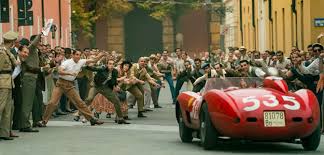🎬 Ferrari (2023)

Ferrari (2023) Movie Review: A High-Octane Biopic That Races Through Passion and Tragedy
Introduction
Michael Mann’s Ferrari (2023) is a high-powered biopic that takes audiences deep into the life of Enzo Ferrari, the legendary founder of the iconic Italian automobile company. Starring Adam Driver as Enzo Ferrari, the film explores a pivotal year in his life—1957—a time of immense personal and professional turmoil. Mann, known for his meticulous attention to detail and stylish storytelling (Heat, Collateral), brings his signature flair to this deeply compelling character study. But does Ferrari live up to its name and legacy, or does it stall on the cinematic racetrack?
Plot Summary
Set in the summer of 1957, Ferrari follows Enzo Ferrari at a crucial moment in his life. The film captures the intense pressure he faces as his company teeters on the brink of financial collapse while his personal life spirals out of control. Ferrari is dealing with the recent loss of his son, Dino, whose death still haunts him and his estranged wife, Laura (played by Penélope Cruz). Meanwhile, his relationship with his longtime mistress, Lina Lardi (Shailene Woodley), and their illegitimate son Piero adds another layer of emotional complexity to his life.
The narrative revolves around Ferrari’s desperate attempt to save his business by securing victory at the grueling Mille Miglia, a thousand-mile open-road endurance race across Italy. The film follows the preparations, tensions, and ultimate tragedy that unfolds during the race, showcasing Ferrari’s relentless drive for success and his willingness to take risks—both personal and professional.
Adam Driver’s Captivating Performance
Adam Driver delivers a powerhouse performance as Enzo Ferrari, portraying the character with a mix of arrogance, brilliance, and vulnerability. His transformation into the Italian entrepreneur is nothing short of remarkable, from his distinct accent to the intense emotional weight he carries throughout the film. Driver’s ability to balance Ferrari’s cold, calculating business persona with his deep internal struggles makes the character feel both larger-than-life and profoundly human.
Penélope Cruz is equally exceptional as Laura Ferrari. Her portrayal of a grieving mother and embittered wife adds a raw emotional depth to the film. Her explosive confrontations with Enzo are among the most gripping scenes, showcasing her ability to command the screen with fiery passion. Meanwhile, Shailene Woodley, as Lina Lardi, provides a more subdued but significant presence, depicting a woman who exists in the shadows of Ferrari’s chaotic world.
Direction and Cinematography
Michael Mann’s direction is precise and visually stunning. He immerses viewers in the world of 1950s Italy, capturing the elegance, danger, and raw energy of the racing scene. The cinematography, led by Erik Messerschmidt, beautifully blends period aesthetics with modern filmmaking techniques, creating breathtaking race sequences that make audiences feel the speed and peril of Mille Miglia.
Mann’s attention to detail is evident in every frame—from the meticulously recreated Ferrari cars to the authentic costumes and production design. The use of natural lighting and dynamic camera movements enhances the film’s realism, making it feel as though the audience is right there, experiencing the highs and lows alongside the characters.
The Thrill of Racing Sequences
One of the film’s greatest strengths is its depiction of racing. Unlike Ford v Ferrari (2019), which focused on the rivalry between racing giants, Ferrari is more of an intimate character-driven drama. However, the racing sequences are still breathtaking. The Mille Miglia race is a standout moment, with edge-of-your-seat tension and a visceral sense of danger. The film does not glorify the sport but rather highlights its deadly risks, culminating in a shocking and tragic real-life accident that underscores the high stakes Ferrari faced.
The sound design plays a crucial role in immersing viewers in these sequences. The roar of engines, the screech of tires, and the sudden silences during moments of tension all contribute to the film’s intensity. Combined with an evocative score by Daniel Pemberton, the racing scenes become an auditory and visual spectacle.
Themes and Symbolism
Beyond the exhilarating race sequences, Ferrari delves into themes of ambition, loss, and sacrifice. The film paints a complex portrait of Enzo Ferrari, portraying him as a man whose relentless pursuit of perfection came at a great personal cost. His struggle to balance his public persona with his private pain adds depth to the story, making it more than just a film about fast cars—it’s a story about the human cost of greatness.
The film also explores the fragility of life, as evidenced by the devastating consequences of pushing the limits of speed. The Mille Miglia tragedy serves as a stark reminder that Ferrari’s pursuit of excellence came at the expense of human lives, a burden that he carries heavily.
Historical Accuracy and Dramatic Liberties
Like many biopics, Ferrari takes some creative liberties with historical events for dramatic effect. While the film stays largely true to the key events of 1957, certain aspects are condensed or slightly altered for storytelling purposes. However, these changes do not detract from the film’s authenticity. Mann’s dedication to historical accuracy is evident in the meticulous recreation of the era, from the cars to the settings.
That said, some viewers might find the pacing of the film slower than expected, as it prioritizes character exploration over high-speed action. Those looking for a non-stop racing movie may be surprised by the film’s introspective nature.
Audience and Critical Reception
Upon release, Ferrari received widespread acclaim for its performances, direction, and historical accuracy. Critics praised Adam Driver’s commanding portrayal of Enzo Ferrari and Penélope Cruz’s standout performance. The film’s cinematography and racing sequences were also lauded for their authenticity and intensity.
However, some critics noted that the film’s pacing and heavy focus on Ferrari’s personal life might not appeal to all viewers. While racing enthusiasts will appreciate the technical precision, casual audiences expecting a more action-packed experience may find it slower than anticipated.
Conclusion: Does Ferrari Cross the Finish Line?
Ferrari (2023) is an expertly crafted biopic that offers a gripping look into the life of one of the most influential figures in automotive history. Michael Mann’s direction, combined with Adam Driver’s transformative performance and breathtaking racing sequences, makes for a compelling and emotionally charged cinematic experience.
While the film may not be a traditional high-speed action movie, its exploration of ambition, loss, and legacy sets it apart as a powerful character study. Whether you’re a racing fan, a history buff, or simply a lover of well-crafted dramas, Ferrari delivers a riveting ride through one man’s pursuit of greatness and the cost that comes with it.
In the end, Ferrari does not just tell the story of a man—it tells the story of a dream driven to its limits. And for that, it firmly secures its place as one of the most captivating biopics of recent years.










